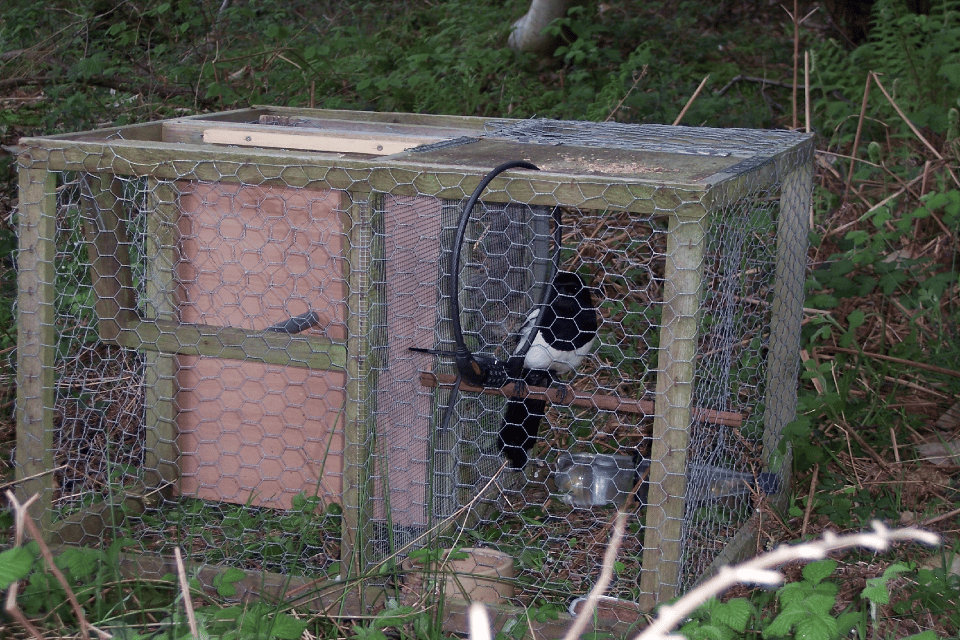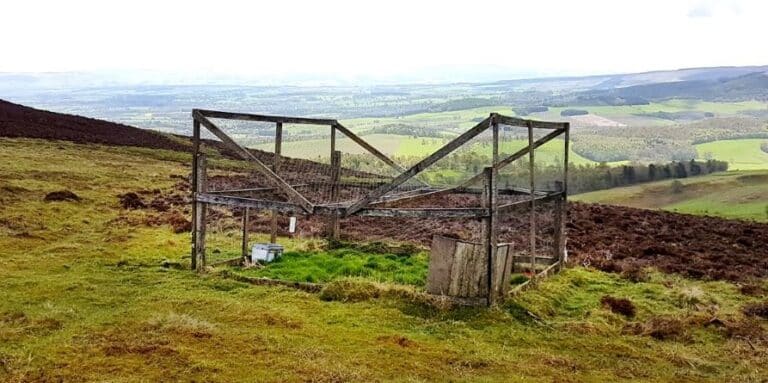Live-catch cages / Crow Traps
Crow Traps
Crow Traps are widely used by gamekeepers on shooting estates to trap and hold (then later kill by shooting or clubbing) corvids (crows, including magpies).
As distressing as finding wild birds trapped in a cage trap may be, their use is legal – but only under strict conditions and by a licenced user.
There are however numerous reports of birds of prey being trapped illegally and then killed, so it is essential we know the rules around their use.

Two types of live-catch cages are widely used: Larsen traps and Cage/Crow traps.
Larsen Traps
Larsen traps are the smaller of the two and are light and compact enough to be moved around and used in different locations. They have two or three (sometimes more) compartments. The largest compartment is for holding either bait or a live bird to act as a decoy. The other compartment(s) are for catching the birds enticed into the trap.
Cage traps
Cage traps are mainly used to catch Carrion Crows, Rooks, Magpies, and Jackdaws. It is illegal to use them to catch any protected bird – which includes any species of raptor – and illegal for the operator not to release a so-called ‘non target’ bird immediately. Wild birds and other wild animals are considered to be under an operator’s control if they are in a trap and are therefore protected by the Animal Welfare Act 2006.
Trapping is permitted under the authority of relevant general licences issued by the Department for Environment Food & Rural Affairs (DEFRA) for England, Natural Resources Wales (NRW) for Wales, NatureScot for Scotland, and the Department of Agriculture, Environment and Rural Affairs (DAERA) for Northern Ireland.
Conditions of use
If even one of the conditions listed below are not being met then the trap is being used illegally and a crime is being committed.
Traps must be set in a location that minimises the likelihood of:
- capturing non-target species
- an unauthorised person interfering with the trap
- non-target species damaging the trap, or harming themselves or trapped animals
- target species being harmed when they’re held in the trap.
When in use, traps must be physically inspected at least every 25 hours. ‘Physically inspected’ means an inspection that is sufficient to check if:
- any animal has been trapped - including the identification and physical condition of the trapped animal
- any decoy bird held within the trap is in good health
- there is food and water in sufficient quantity and condition
- the trap is operating effectively.
Decoy birds
Cage traps often hold a decoy bird, used to attract other birds to the cage. In England and Wales current law (as of Jan 2022) ONLY the following species are allowed to be used as decoys:
- Carrion Crow Corvus corone
- Jackdaw Corvus monedula
- Jay Garrulus glandarius (NB a Jay may never be used in Scotland)
- Magpie Pica pica
- Monk Parakeet Myiopsitta monachus (considered a non-native species)
- Ring-necked Parakeet Psittacula krameri (considered a non-native species)
- Rook Corvus frugilegus
- In Scotland Hooded Crows Corone cornix may be used as well.Rook Corvus frugilegus
It is illegal to use ANY other bird species as a decoy. Note feral pigeons are sometimes used to attract birds of prey: this is illegal.
It is illegal to use any sound recording as a decoy.
It is illegal to clip a decoy’s wings. If they escape or are released, clipped wings would make them highly susceptible to predators or attack.
Decoy bird welfare
The welfare of decoy birds is well-covered by law. If any of the following conditions are not being met then the trap is being operated illegally:
- suitable food must be readily accessible
- clean drinkable water must be available all of the time
- there must be shelter which protects the bird from prevailing weather conditions
- there must be a perch placed under the shelter
- no decoy bird can be left in a trap when the trap is not in use
- operators can not use any live bird or animal which is tethered, or secured by means of braces or other similar appliances, or is blind, maimed or injured.
Operating a cage trap
The law is clear on how a trap must be operated
- ALL Non-target species caught in a cage trap must be released UNHARMED immediately upon discovery. At each inspection any dead animal, including any dead bird, caught in the trap should be removed from it.
- Any birds killed in accordance with the general licences must be killed in a quick and humane manner (in Wales the general licences require that any bird held captive before being killed must be killed out of sight of other captive birds). In England a separate licence issued by Natural England is required to shoot a trapped bird.
- In Scotland each trap must carry a sign that gives the operator’s ID number and the number of the local police station or the Wildlife Crime Officer for the area.
Additionally it is an offence
- to keep or confine any bird in any cage or receptacle which is not sufficient in height, length or breadth to permit the bird to stretch its wings freely.
- to set a trap in a position which is calculated to cause bodily injury to any wild bird coming into contact with it.

Not in use
The law is clear on how a trap must be secured or immobilised when not in use
- In Scotland when any trap is not in use it must be immobilised and rendered incapable of use.When any multi-catch cage trap is not in use access doors must be removed or securely padlocked so that no bird can be confined. Any other traps, when not in use, must be rendered incapable of catching any birds or animals by either removing from the site or securing shut with a padlock. Any Larsen mate or Larsen pod trap must be firmly pegged or staked down or tethered prior to use so that it cannot be moved should a non-target animal be caught.
- In Wales when any cage trap is not in use it must be immobilised and rendered incapable of use in such a way that the immobilisation could not be reversed without considerable foresight and difficulty. In order to render any cage traps incapable of holding or catching birds or other animals, it’s necessary to either secure the door in a fully open or closed position, secured with a padlock, or to remove the door completely. When any Larsen trap is not in use, it shall be removed from site and stored in such a manner as to prevent its accidental use.
- In England when a cage trap is not in use it must be rendered incapable of holding or catching birds or other animals. Any bait, food, water or decoy birds must also be removed.
Trap being used illegally?
If a trap is being used illegally and it is safe to do so:
- Make a note of the date and time and take photographs or video of the scene using a mobile phone or camera etc (or make as accurate a sketch as possible).
- Note the location of the trap as accurately as possible, preferably using a grid reference (free smartphone apps are widely available). If the crime is in an urban area note the address or any other recognisable description of the location.
- If in the countryside take wide angle photographs of any landmarks (a tree, a distinctive fenceline, a hill) that might help officers relocate the crime scene. Imagine we were trying to find the same site again – what information might we need?
- Photograph any vehicle registration numbers that are or might be related to the incident. Even if we’re not sure whether the vehicle is involved or not it is legal to record a registration number if we suspect that the vehicle has been or may be used in a crime. The number may well be useful to the authorities in the future and help build up a more complete picture of eg an egg collector’s movements.
- If you see someone committing a crime related to use of a cage trap – and if it is safe to do so – take as many photographs as you can. Recording the offender’s face is important of course, but their clothing, the bags they’re carrying, the equipment they’re using are all important too.
Do NOT try to get too close – taking some long-distance images is better than having a camera smashed or being attacked and hurt.
Report
If you find a cage trap that is being operated illegally call 999 and ask to speak to a wildlife crime officer. Give details as requested, and ask for a crime reference number. If you prefer you can call Crimestoppers anonymously on 0800 555 111.
If there is a non-target species trapped in the cage (particularly if the species is protected) an extra option is to also call an animal welfare charity:
- Contact the RSPB and ask to speak to an Investigations Officer
- England and Wales – RSPCA Cruelty line 0300 1234 999
- Scotland – Scottish SPCA Animal Helpline 03000 999 999
- Northern Ireland – USPCA Animal Information Line 028 3025 1000, caller ID required
